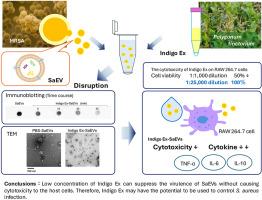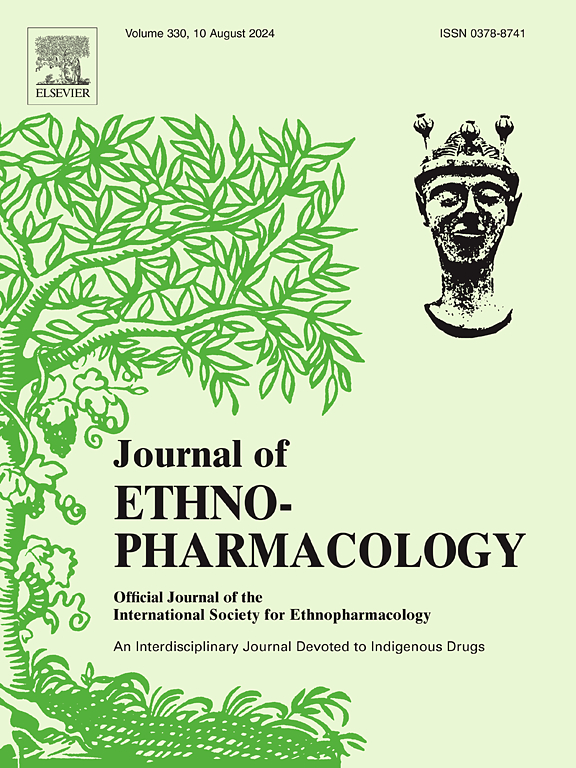何首乌提取物通过破坏细胞外囊泡抑制耐甲氧西林金黄色葡萄球菌的毒性。
IF 4.8
2区 医学
Q1 CHEMISTRY, MEDICINAL
引用次数: 0
摘要
民族药理学意义:耐甲氧西林金黄色葡萄球菌(MRSA)是引起医院和社区获得性感染的全球重大健康问题。金黄色葡萄球菌释放的细胞外囊泡(SaEVs)含有与细菌存活和致病性相关的重要因子。传统上,何首乌被用作天然染料(靛蓝)和治疗由微生物引起的各种感染性疾病。然而,蓼蓝提取物(Indigo Ex)对 SaEVs 的影响及其机制尚不清楚:研究目的:我们研究了靛蓝提取物(Indigo Ex)对SaEVs的作用及其机制,它可用于控制金黄色葡萄球菌,尤其是MRSA感染:材料和方法:靛蓝提取物由不含农药的靛蓝(P. tinctorium)制备,靛蓝干燥、粉末化并用d-柠檬烯提取。采用梯度超速离心法从 MRSA 培养上清液中分离纯化 SaEVs。在振荡条件下培养靛蓝 Ex 和 SaEVs 后,用透射和扫描电子显微镜观察靛蓝 Ex 对 SaEVs 形态的影响。使用小鼠巨噬细胞系 RAW 264.7 检验了 Indigo Ex 的细胞毒性。此外,还通过 ELISA 和 WST-1 试验分别评估了经 Indigo Ex 处理的 SaEV 对 RAW 264.7 细胞的免疫反应刺激能力和细胞毒性:结果:用未稀释的靛蓝前处理 SaEV 粒子时,其破坏程度与时间有关。在靛蓝前体对 RAW 264.7 细胞的细胞毒性方面,当靛蓝前体稀释 1000 倍时,细胞存活率下降了 50%以上,而当靛蓝前体稀释 25000 倍时,则没有观察到细胞毒性作用。有趣的是,经靛蓝前体处理的 SaEVs 比单独的 SaEVs 显示出更小的细胞毒性作用。同样,与未经处理的 SaEVs 相比,经 Indigo Ex 处理的 SaEVs 可减少对 RAW 264.7 细胞中促炎细胞因子(TNF-α 和 IL-6)和抗炎细胞因子(IL-10)的刺激。我们的研究结果表明,靛蓝前体破坏了 SaEV 颗粒,从而降低了毒性并刺激了免疫反应:本研究揭示了低浓度的靛蓝前体可以抑制 SaEVs 的毒力,而不会对宿主细胞造成细胞毒性。因此,靛蓝前体有可能用于控制金黄色葡萄球菌感染。本文章由计算机程序翻译,如有差异,请以英文原文为准。

Polygonum tinctorium extract suppresses the virulence of methicillin-resistant Staphylococcus aureus by disrupting its extracellular vesicles
Ethnopharmacological relevance
Methicillin-resistant S. aureus (MRSA) is a significant global health concern, causing both hospital- and community-acquired infections. The extracellular vesicles released by S. aureus (SaEVs) contain essential factors related to the bacterial survival and pathogenicity. Polygonum tinctorium is traditionally used as a natural dye (indigo) and for treating various infectious diseases caused by microorganisms. However, the effect of P. tinctorium extract (Indigo Ex) and its mechanism on SaEVs is unknown.
Aim of the study
We investigated the effect and mechanism of Indigo Ex on SaEVs, which could be used in controlling S. aureus, especially MRSA infection.
Materials and methods
Indigo Ex was prepared from pesticide-free P. tinctorium, which was dried, powdered, and extracted with d-limonene. SaEVs were isolated and purified from MRSA culture supernatant by step-gradient ultracentrifugation. The effect of Indigo Ex on SaEVs morphology was observed by both transmission and scanning electron microscopy after incubating the Indigo Ex and SaEVs under shaking conditions. The cytotoxicity of Indigo Ex was performed using mouse macrophage cell line, RAW 264.7. In addition, the ability of Indigo Ex-treated SaEVs to stimulate the immune response and cytotoxicity in RAW 264.7 cells were evaluated by ELISA and WST-1 assay, respectively.
Results
SaEV particles were disrupted when treated with undiluted Indigo Ex in a time-dependent manner. For the cytotoxicity of Indigo Ex on RAW 264.7 cells, over 50% of the cell viability decreased when diluted Indigo Ex 1000-fold and no cytotoxic effect was observed at a 25,000-fold dilution of Indigo Ex. Interestingly, the Indigo Ex-treated SaEVs showed less cytotoxic effect than SaEVs alone. Similarly, SaEVs treated with Indigo Ex reduced stimulation of pro-inflammatory cytokines (TNF-α and IL-6) and anti-inflammatory cytokine (IL-10) in RAW 264.7 cells compared to untreated SaEVs. Our results indicate that Indigo Ex disrupted SaEV particles, resulting in reduced virulence and stimulation of immune response.
Conclusions
This study reveals that the low concentration of Indigo Ex can suppresses the virulence of SaEVs without causing cytotoxicity to the host cells. Therefore, Indigo Ex may have the potential to be used to control S. aureus infection.
求助全文
通过发布文献求助,成功后即可免费获取论文全文。
去求助
来源期刊

Journal of ethnopharmacology
医学-全科医学与补充医学
CiteScore
10.30
自引率
5.60%
发文量
967
审稿时长
77 days
期刊介绍:
The Journal of Ethnopharmacology is dedicated to the exchange of information and understandings about people''s use of plants, fungi, animals, microorganisms and minerals and their biological and pharmacological effects based on the principles established through international conventions. Early people confronted with illness and disease, discovered a wealth of useful therapeutic agents in the plant and animal kingdoms. The empirical knowledge of these medicinal substances and their toxic potential was passed on by oral tradition and sometimes recorded in herbals and other texts on materia medica. Many valuable drugs of today (e.g., atropine, ephedrine, tubocurarine, digoxin, reserpine) came into use through the study of indigenous remedies. Chemists continue to use plant-derived drugs (e.g., morphine, taxol, physostigmine, quinidine, emetine) as prototypes in their attempts to develop more effective and less toxic medicinals.
 求助内容:
求助内容: 应助结果提醒方式:
应助结果提醒方式:


